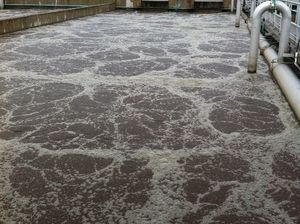
8 Must-Take Steps to Rectify Elevated Ammonia in Effluent
Permit effluent limits for ammonia are becoming more stringent, making its removal one of the most important and most difficult processes to maintain in water resource recovery. Completion of the treatment process in many systems requires its removal through nitrification, a sequential, 2-step biological process by which aerobic bacteria oxidize ammonium to nitrate:

- Ammonia-oxidizing bacteria (AOB) oxidize ammonium ions (NH4+) to nitrite (NO2-).
- Nitrite-oxidizing bacteria (NOB) oxidize nitrite to nitrate (NO3-).
The full 2-step conversion—important because both ammonia and nitrites are toxic and can cause permit exceedances—is accomplished by maintaining two types of nitrifying bacteria: Nitrosomonas and Nitrobacter.
- Both types of nitrifiers are autotrophs, meaning they build cellular materials using carbon dioxide or carbonate and obtain energy from the chemical conversion of ammonia into nitrite and nitrate.
- Because they obtain less energy during their metabolic processes compared to more common heterotrophic wastewater bacteria—which require organic carbon for growth—their cellular growth is slower.
- This is especially true of Nitrosomonas, the bacteria responsible for the conversion of ammonia into nitrite in step 1, which in turn limits the growth of Nitrobacter.
If a wastewater treatment plant’s ammonia levels are elevated, here are 8 must-take steps to follow to get waste outflow back on track.

8 must-take steps
1. Treat with a supplemental nitrifier product to immediately knock down ammonia levels.
This is typically done with high volumes of product added daily over a week-long period until ammonia levels stay down, while work is done simultaneously to identify and correct the issue that caused the upset in the first place. Though the system’s nitrifier population would eventually recover on its own, it would take weeks or months due to their slow growth, and fines are typically issued each day that permitted ammonia levels are exceeded.
2. Check dissolved oxygen (DO) levels.
Nitrifiers are obligate aerobes, meaning they require free molecular oxygen and are killed off by anaerobic conditions—though an absence of oxygen for less than 4 hours will not adversely affect them. In fact, approximately 4.6 kg of oxygen are required for every kg of ammonium ions oxidized to nitrate (compared with a requirement of just 1 kg of oxygen to oxidize 1 kg of carbonaceous BOD). To ensure effective nitrification, always maintain a DO level equal to or greater than 1.5 mg/L.
a. Maximum nitrification occurs at a DO level of 3.0 mg/L.
b. Significant nitrification occurs at a DO level of 2.0 to 2.9 mg/L.
c. Nitrification ceases at DO levels of less than 0.5 mg/L.
3. Verify appropriate lagoon water temperature.
Nitrification is temperature sensitive, and nitrifiers do not like extreme temperatures, exhibiting poor efficiency below 15°C (59°F) and above 35°C (95°F). The optimum temperature for nitrification is generally considered to be 30°C (86°F).
4. Test and, if necessary, correct lagoon pH.
The nitrification process is also sensitive to pH, with acidic conditions being particularly adverse. pH is acceptable for nitrification within a range of 6.5–9, with the best rates occurring above a pH of 7.5 and below a pH of 8.
5. Ensure adequate alkalinity.
Nitrification consumes alkalinity, utilizing approximately 7 pounds of alkalinity for 1 pound of ammonia. Nitrification will continue to occur at alkalinity levels below 40 ppm (as CACO3), though the optimum range is below 100 ppm.
6. Consider lengthening SRTs (sludge retention times).
Because autotrophs are comparatively slow growing with a low cell yield (each pound of nitrified ammonia yields a mere 0.15 pounds of new cells), sludge age must be kept high enough to maintain their population. Also, BOD must be removed before nitrification, because autotrophs do not compete well against the heterotrophs that remove BOD.
7. Provide nutrition.
Phosphorous levels, in particular, tend to become deficient, and a measurable amount should be present for optimum nitrification. Other elements to measure include calcium, iron, magnesium, and molybdenum, as well as copper, nickel, and zinc—the latter 3 of which are needed but toxic at high concentrations.
8. Check for toxicity or other changes to the incoming waste stream.
Pollutants—such as metals (mentioned in #7 above), chemicals, FOGs, and many more—or their concentrations in the influent may have changed and be inhibiting nitrification. The incoming ammonia, BOD, or COD loads may have also increased, making it such that the current operating set up can’t handle the new load. Remember, ammonia in wastewater could originate from a variety of sources, including proteins (meat and blood), urea, amino acid products, casein, corrosion inhibitors, process chemicals and raw materials, or cleaning chemicals containing quaternary ammonium compounds.
When an upset or overload occurs leading to high levels of ammonia in effluent, we recommend our new and robust product below for use as a supplemental nitrifier. It contains both AOB and NOB organisms that perform a rapid and full 2-step nitrification conversion. It can also be used to initiate or supplement the nitrification process in a non-emergency situation.
Loading...
Through our new Microscopic Analysis service, we are also happy to help diagnose and treat issues, including but not limited to those listed above.
For any water and environmental technologies challenge, EnviroZyme is here to help.